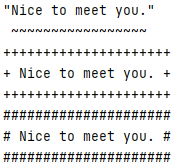| Creational Pattern | Structural Pattern | Behavioral Pattern | |
|---|---|---|---|
| Description | Provides object creation mechanisms, which increase flexibility and reuse of existing code. | Explain how to assemble objects and classes into larger structures while keeping these structures flexible and efficient. | Concerned with algorithms and the assignment of responsibilities between objects. |
| ID | Name | Description | Visualization |
|---|---|---|---|
| 1 | Factory Method | Provides an interface for creating objects in a superclass, but allows subclasses to alter the type of objects that will be created. |  |
| 2 | Abstract Factory | Lets you produce families of related objects without specifying their concrete classes. |  |
| 3 | Builder | Lets you construct complex objects step by step. The pattern allows you to produce different types and representations of an object using the same construction code. |  |
| 4 | Singleton | Lets you ensure that a class has only one instance while providing a global access point to this instance. |  |
| 5 | Prototype | Lets you copy existing objects without making your code dependent on their classes. |  |
| ID | Name | Description | Visualization |
|---|---|---|---|
| 1 | Adapter | Allows objects with incompatible interfaces to collaborate. |  |
| 2 | Bridge | Lets you split a large class or a set of closely related classes into two separate hierarchies - abstraction and implementation - which can be developed independently of each other. |  |
| 3 | Composite | Lets you compose objects into tree structures and then work with these structures as if they were individual objects. |  |
| 4 | Decorator | Lets you attach new behaviors to objects by placing these objects inside special wrapper objects that contain the behaviors. |  |
| 5 | Facade | Provides a simplified interface to a library, a framework, or any other complex set of classes. |  |
| 6 | Flyweight | Lets you fit more objects into the available amount of RAM by sharing common parts of state between multiple objects instead of keeping all of the data in each object. |  |
| 7 | Proxy | Lets you provide a substitute or placeholder for another object. A proxy controls access to the original object, allowing you to perform something either before or after the request gets through to the original object. |  |
| ID | Name | Description | Visualization |
|---|---|---|---|
| 1 | Chain of Responsibility | Lets you pass requests along a chain of handlers. Upon receiving a request, each handler decides either to process the request or to pass it to the next handler in the chain. |  |
| 2 | Command | Turns a request into a standalone object that contains all info about the request. This transformation lets you pass requests as method arguments, delay or queue a request's execution, and support undoable operations. |  |
| 3 | Iterator | Lets you traverse elements of a collection without exposing its underlying representation (list, stack, tree, etc.). |  |
| 4 | Mediator | Lets you reduce chaotic dependencies between objects. The pattern restricts direct communication between the objects and forces them to collaborate only via a mediator object. |  |
| 5 | Memento | Lets you save and restore previous state of an object without revealing the details of its implementation. |  |
| 6 | Observer | Lets you define a subscription mechanism to notify multiple objects about any events that happen to the object they're observing. |  |
| 7 | State | Lets an object alter its behavior when its internal state changes. It appears as if the object changed its class. |  |
| 8 | Strategy | Lets you define a family of algorithms, put each of them into a separate class, and make their objects interchangeable. |  |
| 9 | Template Method | Defines a skeleton of an algorithm in the superclass but lets subclasses override specific steps of the algorithm without changing its structure. |  |
| 10 | Visitor | Lets you separate algorithms from the objects on which they operate. |  |
This project lists UML diagrams of the "Design Pattern Examples in Python". When you click on a diagram image, the diagram will be opened in Diagram Map. If you want to know about Diagram Map, see this post.
| 1. Abstract Factory | 2. Builder | 3. Factory Method |
Python Code  |
Python Code  |
Python Code  |
| 4. Prototype | 5. Singleton | |
Python Code  |
Python Code  |
| 1. Adapter | 2. Bridge | 3. Composite |
Python Code  |
Python Code  |
Python Code  |
| Decorator | Facade | Flyweight |
Python Code  |
Python Code  |
Python Code  |
| Proxy | ||
Python Code  |
| 1. Chain of Responsibility | 2. Command | 3. Interpreter |
Python Code  |
Python Code  |
Python Code  |
| 4. Iterator | 5. Mediator | 6. Memento |
Python Code  |
Python Code  |
Python Code  |
| 7. Observer | 8. State | 9. Strategy |
Python Code  |
Python Code  |
Python Code  |
| 10. Template Method | 11. Visitor | |
Python Code  |
Python Code  |
- Gamma, E. et al. Design Patterns: Elements of Reusable Object-Oriented Software, Addison-Wesley, 1994
- Hiroshi Yuki. Learning Design Patterns in Java [In Japanese Language], Softbank publishing, 2004
Diagram Map file (DiagramMap.html) includes the following libraries:
- D3 library is copyrighted by Mike Bostock and is released under the BSD license.
- Popper library is copyrighted by Federico Zivolo and is released under the MIT license.
- Tippy library is copyrighted by atomiks and is released under the MIT license.